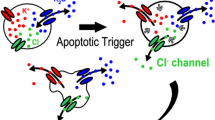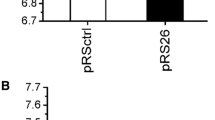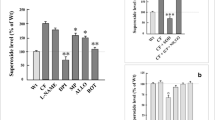Abstract
Cystic fibrosis transmembrane conductance regulator (CFTR) is the essential chloride and bicarbonate channel in the apical membrane of epithelial cells. CFTR was also proposed earlier to conduct glutathione (GSH) out of airway epithelial cells to be enriched in the apical airway surface liquid to neutralize reactive oxygen species (ROS). Although earlier studies suggested that release of GSH by wild type (wt) CFTR may lead to an increase in cytosolic ROS, we did not detect different ROS levels in cells expressing wt-CFTR and mutant F508del-CFTR, independent of CFTR-activation or exposure to the ROS donor tert-butyl hydroperoxide. The Ca2+-activated phospholipid scramblase and ion channel TMEM16F (anoctamin 6, ANO6) is also expressed in airway cells. ANO6 produced outwardly rectifying Cl− currents (ORCC) and scrambled plasma membrane phospholipids when activated by increase in cytosolic ROS and consecutive peroxidation of plasma membrane lipids. ANO6 activity is enhanced by CFTR, probably through translocation of signaling proteins to the plasma membrane. The present data suggest that enhanced cell death in CFTR-expressing cells is due to upregulation of ANO6-activity. In ANO6 knockout mice, the number of apoptotic cells in the intestinal epithelium was strongly reduced, supporting the role of ANO6 for cell death. Thus, ANO6 and CFTR act cooperatively on ROS-mediated cell death, which is not further augmented by cAMP-dependent stimulation. We propose that ANO6 supports cell death correlated with expression of CFTR, possibly by inducing ferroptosis.






Similar content being viewed by others
References
Benedetto R, Ousingsawat J, Wanitchakool P, Zhang Y, Holtzman MJ, Amaral M, Rock JR, Schreiber R, Kunzelmann K (2017) Epithelial chloride transport by CFTR requires TMEM16A. Sci Rep (resubmitted). https://doi.org/10.1096/fj.201600797RR
Botelho HM, Uliyakina I, Awatade NT, Proenca MC, Tischer C, Sirianant L, Kunzelmann K, Pepperkok R, Amaral MD (2015) Protein traffic disorders: an effective high-throughput fluorescence microscopy pipeline for drug discovery. Sci Rep 5:9038
Bradbury NA, Jilling T, Gabor B, Sorscher EJ, Bridges RJ, Kirk KL (1992) Regulation of plasma membrane recycling by CFTR. Science 256:530–531
Brunner JD, Lim NK, Schenck S, Duerst A, Dutzler R (2014) X-ray structure of a calcium-activated TMEM16 lipid scramblase. Nature 516:207–212
Brunner JD, Schenck S, Dutzler R (2016) Structural basis for phospholipid scrambling in the TMEM16 family. Curr Opin Struct Biol 39:61–70. https://doi.org/10.1016/j.sbi.2016.05.020
Cantin AM, North SL, Hubbard RC, Crystal RG (1987) Normal alveolar epithelial lining fluid contains high levels of glutathione. J Appl Physiol (1985) 63:152–157
Conner GE, Ivonnet P, Gelin M, Whitney P, Salathe M (2013) H2O2 stimulates cystic fibrosis transmembrane conductance regulator through an autocrine prostaglandin pathway, using multidrug-resistant protein-4. Am J Respir Cell Mol Biol 49:672–679. https://doi.org/10.1165/rcmb.2013-0156OC
Gabriel SE, Clarke LL, Boucher RC, Stutts MJ (1993) CFTR and outward rectifying chloride channels are distinct proteins with a regulatory relationship. Nature 363:263–268
Gao L, Kim KJ, Yankaskas JR, Forman HJ (1999) Abnormal glutathione transport in cystic fibrosis airway epithelia. Am J Phys 277:L113–L118
Grubb S, Poulsen KA, Juul CA, Kyed T, Klausen TK, Larsen EH, Hoffmann EK (2013) TMEM16F (anoctamin 6), an anion channel of delayed Ca2+ activation. J Gen Physiol 141:585–600
Hwang T-C, Lu L, Zeitlin PL, Gruenert DC, Huganir R, Guggino WB (1989) Cl− channels in CF: lack of activation by protein kinase C and cAMP-dependent protein kinase. Science 244:1351–1353
Ivonnet P, Salathe M, Conner GE (2015) Hydrogen peroxide stimulation of CFTR reveals an Epac-mediated, soluble AC-dependent cAMP amplification pathway common to GPCR signalling. Br J Pharmacol 172:173–184. https://doi.org/10.1111/bph.12934
Jungas T, Motta I, Duffieux F, Fanen P, Stoven V, Ojcius DM (2002) Glutathione levels and BAX activation during apoptosis due to oxidative stress in cells expressing wild-type and mutant cystic fibrosis transmembrane conductance regulator. J Biol Chem 277:27912–27918
Juul CA, Grubb S, Poulsen KA, Kyed T, Hashem N, Lambert IH, Larsen EH, Hoffmann EK (2014) Anoctamin 6 differs from VRAC and VSOAC but is involved in apoptosis and supports volume regulation in the presence of Ca. Pflugers Arch 466:1899–1910
Khan TZ, Wagener JS, Bost T, Martinez J, Accurso FJ, Riches DW (1995) Early pulmonary inflammation in infants with cystic fibrosis. Am J Respir Crit Care Med 151:1075–1082. https://doi.org/10.1164/ajrccm.151.4.7697234
Kogan I, Ramjeesingh M, Li C, Kidd JF, Wang Y, Leslie EM, Cole SP, Bear CE (2003) CFTR directly mediates nucleotide-regulated glutathione flux. EMBO J 22:1981–1989
Kumar N, Gupta S, Dabral S, Singh S, Sehrawat S (2017) Role of exchange protein directly activated by cAMP (EPAC1) in breast cancer cell migration and apoptosis. Mol Cell Biochem 430:115–125. https://doi.org/10.1007/s11010-017-2959-3
Kunzelmann K (2016) Ion channels in regulated cell death. Cell Mol Life Sci 73:2387–403
Kunzelmann K, Pavenstädt H, Greger R (1989) Properties and regulation of chloride channels in cystic fibrosis and normal airway epithelial cells. Pflügers Arch 415:172–182
L'hoste S, Chargui A, Belfodil R, Corcelle E, Duranton C, Rubera I, Poujeol C, Mograbi B, Tauc M, Poujeol P (2010) CFTR mediates apoptotic volume decrease and cell death by controlling glutathione efflux and ROS production in cultured mice proximal tubules. Am J Physiol Renal Physiol 298:F435–F453
L'hoste S, Chargui A, Belfodil R, Duranton C, Rubera I, Mograbi B, Poujeol C, Tauc M, Poujeol P (2009) CFTR mediates cadmium-induced apoptosis through modulation of ROS level in mouse proximal tubule cells. Free Radic Biol Med 46:1017–1031
Lobo MJ, Amaral MD, Zaccolo M, Farinha CM (2016) EPAC1 activation by cAMP stabilizes CFTR at the membrane by promoting its interaction with NHERF1. J Cell Sci. https://doi.org/10.1242/jcs.185629
Luciani A, Villella VR, Esposito S, Brunetti-Pierri N, Medina D, Settembre C, Gavina M, Pulze L, Giardino I, Pettoello-Mantovani M, D'Apolito M, Guido S, Masliah E, Spencer B, Quaratino S, Raia V, Ballabio A, Maiuri L (2010) Defective CFTR induces aggresome formation and lung inflammation in cystic fibrosis through ROS-mediated autophagy inhibition. Nat Cell Biol 12:863–875
Martins JR, Faria D, Kongsuphol P, Reisch B, Schreiber R, Kunzelmann K (2011) Anoctamin 6 is an essential component of the outwardly rectifying chloride channel. Proc Natl Acad Sci U S A 108:18168–18172
Ousingsawat J, Cabrita I, Wanitchakool P, Sirianant L, Krautwald S, Linkermann A, Schreiber R, Kunzelmann K (2016) Ca2+ signals, cell membrane disintegration, and activation of TMEM16F during necroptosis. Cell Mol Life Sci. https://doi.org/10.1007/s00018-016-2338-3
Ousingsawat J, Kongsuphol P, Schreiber R, Kunzelmann K (2011) CFTR and TMEM16A are separate but functionally related Cl channels. Cell Physiol Biochem 28:715–724
Ousingsawat J, Wanitchakool P, Kmit A, Romao AM, Jantarajit W, Schreiber S, Kunzelmann K (2015) Anoctamin 6 mediates effects essential for innate immunity downstream of P2X7-receptors in macrophages. Nat Commun 6:6245
Pedemonte N, Galietta LJ (2014) Structure and function of TMEM16 proteins (anoctamins). Physiol Rev 94:419–459
Rahman I, MacNee W (2000) Oxidative stress and regulation of glutathione in lung inflammation. Eur Respir J 16:534–554
Rego AC, Santos MS, Oliveira CR (1999) Influence of the antioxidants vitamin E and idebenone on retinal cell injury mediated by chemical ischemia, hypoglycemia, or oxidative stress. Free Radic Biol Med 26:1405–1417
Schoumacher RA, Shoemaker RL, Halm DR, Tallant EA, Wallace RW, Frizzell RA (1987) Phosphorylation fails to activate chloride channels from cystic fibrosis airway cells. Nature 330:752–754
Segawa K, Nagata S (2015) An apoptotic ‘eat me’ signal: phosphatidylserine exposure. Trends Cell Biol 25:639–650. https://doi.org/10.1016/j.tcb.2015.08.003
Segawa K, Suzuki J, Nagata S (2011) Constitutive exposure of phosphatidylserine on viable cells. Proc Natl Acad Sci U S A 108:19246–19251
Shimizu T, Iehara T, Sato K, Fujii T, Sakai H, Okada Y (2013) TMEM16F is a component of a Ca2+−activated Cl-channel but not a volume-sensitive outwardly rectifying Cl-channel. Am J Physiol Cell Physiol 304:C748–C759
Sirianant L, Ousingsawat J, Wanitchakool P, Schreiber R, Kunzelmann K (2015) Cellular volume regulation by anoctamin 6: Ca2+, phospholipase A2, osmosensing. Pflügers Arch 468:335–349
Sirianant L, Wanitchakool P, Ousingsawat J, Benedetto R, Zormpa A, Cabrita I, Schreiber R, Kunzelmann K (2016) Non-essential contribution of LRRC8A to volume regulation. Pflügers Arch 468:1789–1796
Soleti R, Porro C, Martinez MC (2013) Apoptotic process in cystic fibrosis cells. Apoptosis 18:1029–1038. https://doi.org/10.1007/s10495-013-0874-y
Suzuki J, Umeda M, Sims PJ, Nagata S (2010) Calcium-dependent phospholipid scrambling by TMEM16F. Nature 468:834–838
Tian Y, Schreiber R, Kunzelmann K (2012) Anoctamins are a family of Ca2+ activated Cl-channels. J Cell Sci 125:4991–4998
Trudel S, Kelly M, Fritsch J, Nguyen-Khoa T, Therond P, Couturier M, Dadlez M, Debski J, Touqui L, Vallee B, Ollero M, Edelman A, Brouillard F (2009) Peroxiredoxin 6 fails to limit phospholipid peroxidation in lung from Cftr-knockout mice subjected to oxidative challenge. PLoS One 4:e6075. https://doi.org/10.1371/journal.pone.0006075
Velsor LW, van Heeckeren A, Day BJ (2001) Antioxidant imbalance in the lungs of cystic fibrosis transmembrane conductance regulator protein mutant mice. Am J Physiol Lung Cell Mol Physiol 281:L31–L38
Wanitchakool P, Ousingsawat J, Sirianant L, Cabrita I, Faria D, Schreiber R, Kunzelmann K (2017) Cellular defects by deletion of ANO10 are due to deregulated local calcium signaling. Cell Signal 30:41–49. https://doi.org/10.1016/j.cellsig.2016.11.006
Wanitchakool P, Ousingsawat J, Sirianant L, MacAulay N, Schreiber R, Kunzelmann K (2016) Cl-channels in apoptosis. Eur Biophys J 45:599–610
Welsh MJ, Li M, McCann JD (1989) Activation of normal and cystic fibrosis Cl channels by voltage, temperature and trypsin. J Clin Invest 84:2002–2007
Yang H, Kim A, David T, Palmer D, Jin T, Tien J, Huang F, Cheng T, Coughlin SR, Jan YN, Jan LY (2012) TMEM16F forms a Ca(2+)-activated cation channel required for lipid scrambling in platelets during blood coagulation. Cell 151:111–122
Acknowledgements
Supported by DFG SFB699-A7/A12, DFG KU756/12-1, and UK CF Trust SRC003 INOVCF.
Author information
Authors and Affiliations
Corresponding author
Rights and permissions
About this article
Cite this article
Simões, F., Ousingsawat, J., Wanitchakool, P. et al. CFTR supports cell death through ROS-dependent activation of TMEM16F (anoctamin 6). Pflugers Arch - Eur J Physiol 470, 305–314 (2018). https://doi.org/10.1007/s00424-017-2065-0
Received:
Revised:
Accepted:
Published:
Issue Date:
DOI: https://doi.org/10.1007/s00424-017-2065-0




